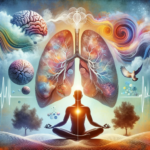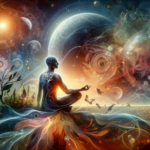Utilising breath control to better manage hypertension.

Utilising breath control to lower blood pressure and reduce stress.
Pundit Acharya, the author of Breath, Sleep, The Heart & Life, once said
“Only those who know how to breathe will survive.”
Breathing is not taught in the West because it’s an unconscious process and has very little attention paid to it. However, for thousands of years, other cultures have taken to breathwork to improve health and wellbeing. Something that gets stigma for being too spiritual in our society.
My goal is to break this stigma and help people use more holistic approaches to improve their health, such a breath control. In this article, I will provide scientific and anecdotal evidence of how breath control can reduce blood pressure as a non-pharmacological tool for patients with hypertension.
It is well established that chronic stress plays a vital role in developing essential hypertension [1]. Due to an imbalance in the autonomic nervous system and a lack of vagal tone, there is a swing towards sympathetic nervous activity—a shift in our default regulating system towards a heightened and poorly managed stress response.
Heart rate increases, ventricular contractions are more forceful, and the blood vessels constrict, leading to a rise in resistance in the circulatory system. As a result, blood pressure increases and, over time, leads to a heightened risk of stroke, heart failure, kidney failure and early death.
Medicine often prescribed by doctors, such as beta-blockers, aims to reduce this stress response and improve the sensitivity of the heart to detect blood pressure changes – a concept called the baroreflex.
But here is the crucial thing, Breath Control can do this too.
Reducing breathing to roughly 6 breath per minute improves the ability of the heart to alter blood pressure in healthy people [2] as well in those with heart failure [3] and high blood pressure [4].
In fact, according to a statement by the American heart association. Controlled breathing is a class IIa procedure with evidence level B making it reasonable to perform the non-invasive therapy for lowering blood pressure with only aerobic exercise having a better outcome in the methods investigated. When performed for eight to nine weeks, breath control showed a blood pressure decrease of 13/7 mmHg, which is enough to drop the severity of hypertension by at least one, and in some cases, two classifications [5]
At the pinnacle of scientific evidence is a meta-analysis. This is a collection of tightly controlled research trials investigating outcomes similarly. Chaddha et al. (2019) concluded that only 10–15 minutes of daily interventions reduce systolic blood pressure by 3.73–8.03 mmHg and diastolic blood pressure by 1.66–4.28 mmHg with further reductions those that practised for longer [6].
I have devised an eight-week stress relief breathing program for patients who suffer from a stress-related disease such as anxiety, high blood pressure, hyperventilation syndromes and even diabetes.
Here I present a case of a patient with early/mild hypertension and breathlessness.
A 37-year-old male presented to the clinic with shortness of breath and mild hypertension. He was frequently sighing, and there was apparent breathing pattern dysfunction. He had a past history of stress and trauma, being an Australian army commando and suffered from testicular cancer. He commenced an eight-week breathing program as I had evidence to believe this would reduce much of his concerns and symptoms.
His breathing protocols at week one started at only 5 minutes per day using a correct breathing technique taught by myself. Each week we have added a new form of breath control to improve his tolerance to Carbon Dioxide, a metabolic stress signal and promote a more relaxed state in his mind and body. Currently, he is spending around 15-20 minutes daily focusing on breathing protocols asset during our weekly consultation.
In just six weeks of online coaching, his BP has dropped from roughly 140/90 mmHg to 125/80 mmHg, almost textbook blood pressure. Heart rate variability measured using his apple watch has increased by 11 points, demonstrating an improvement in his cardiac autonomic control. His perceived stress scale and shortness of breath scores reduced by nearly 50%. He claims to be sleeping better and feel much more focused at work.
Observational, this individual is breathing better, significantly happier, and has received feedback from his friends and family that they notice he is calmer and living a more active lifestyle.
This is only a tiny proportion of the abundant evidence to suggest that breath control can support patients with hypertension and disease related to stress.
So I ask you, if you consider yourself to live a stressful life, are struggling to manage your blood pressure or find yourself anxious and feeling breathless during exercise, reach out for support.
I have placed the citations at the bottom of this article if you wish to do any further reading.
Keep an eye out for more health information related to breathing and sleep coming soon.
Kind regards
Martin McPhilimey
References
Godoy, L.Sparrenberger, F., Cichelero, F. T., Ascoli, A. M., Fonseca, F. P., Weiss, G., Berwanger, O., … & Fuchs, F. D. (2009). Does psychosocial stress cause hypertension? A systematic review of observational studies. Journal of human hypertension, 23(1), 12-19.
LBernardi, L., Sleight, P., Bandinelli, G., Cencetti, S., Fattorini, L., Wdowczyc-Szulc, J., & Lagi, A. (2001). Effect of rosary prayer and yoga mantras on autonomic cardiovascular rhythms: comparative study. Bmj, 323(7327), 1446-1449.
Bernardi, L., Porta, C., Spicuzza, L., Bellwon, J., Spadacini, G., Frey, A. W., … & Tramarin, R. (2002). Slow breathing increases arterial baroreflex sensitivity in patients with chronic heart failure. Circulation, 105(2), 143-145.
Joseph, C. N., Porta, C., Casucci, G., Casiraghi, N., Maffeis, M., Rossi, M., & Bernardi, L. (2005). Slow breathing improves arterial baroreflex sensitivity and decreases blood pressure in essential hypertension. hypertension, 46(4), 714-718.
Brook, R. D., Appel, L. J., Rubenfire, M., Ogedegbe, G., Bisognano, J. D., Elliott, W. J., … & Rajagopalan, S. (2013). Beyond medications and diet: alternative approaches to lowering blood pressure: a scientific statement from the American Heart Association. Hypertension, 61(6), 1360-1383.
Chaddha, A., Modaff, D., Hooper-Lane, C., & Feldstein, D. A. (2019). Device and non-device-guided slow breathing to reduce blood pressure: A systematic review and meta-analysis. Complementary therapies in medicine, 45, 179-184.
Bernardi, L., Gordin, D., Bordino, M., Rosengård-Bärlund, M., Sandelin, A., Forsblom, C., & Groop, P. H. (2017). Oxygen-induced impairment in arterial function is corrected by slow breathing in patients with type 1 diabetes. Scientific reports, 7(1), 1-8.




